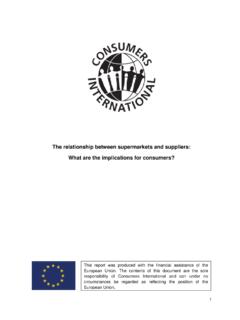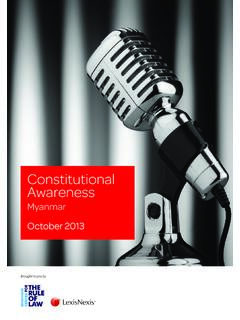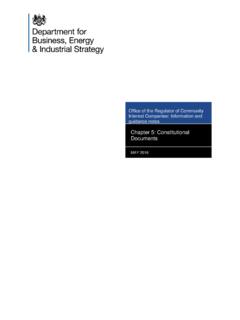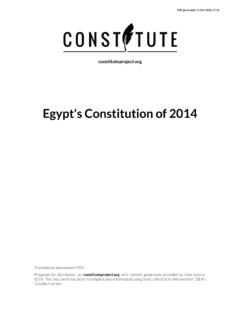Transcription of 11 The Constitutional Separation of Powers
1 220 T R. S. Allan as the basic demand of human dignity. We can envisage a seamless transition from study of the domestic legal regime, specific to a single jurisdiction, to deeper explora-tion of the underlying philosophy of right: the former is underpinned and inspired by the latter. Legal rights and duties are genuine provoking legitimate state force in their defence only when they are features of a scheme of governance that, correctly inter-preted, accords each individual the freedom that his human dignity demands. 11 The Constitutional Separation of Powers Aileen Kavanagh* In the panoply of principles regulating Constitutional government, the Separation of Powers occupies a position of deep ambivalence.
2 On the one hand, all constitu-tional democracies rest on some form of division between three distinct branches of government the legislature, executive, and judiciary. Moreover, within these coun-tries, the Separation of Powers is invoked as an ideal, that is as a standard (or, perhaps, set of standards) to which the legal and Constitutional arrangements of a modern state ought to conform. The assumption is that the Separation of Powers is an ideal worth having and that we gain something valuable by conforming to it. Indeed, this assump-tion has had a long pedigree in the canonical literature on Constitutional theory. In the eighteenth century, the Separation of Powers was hailed as a bulwark against the abuse of state power and the threat of tyranny.
3 Montesquieu wrote that without a Separation of Powers , there would be `no liberty!' The French Declaration of the Rights of Man in 1789 went so far as to suggest that Any society in which the safeguarding of rights is not assured, and the Separation of Powers is not established, has no constitution:2 Right up to the present day, theorists argue that the Separation of Powers is the very 'essence of constitutionalism* and 'a universal criterion of Constitutional government!' However, despite being a pervasive feature of Constitutional democracies, there are deep reservations about the Separation of Powers in contemporary times. The first line of common criticism concerns the perceived stringency of the Separation requirement.
4 If what is required is a complete Separation of three mutually exclusive functions car-ried out by three branches of government hermetically sealed from each other, then this has never been instantiated in any modern state.' Indeed, as one commentator observed, 'if Powers truly were separated so that each branch of government could * Associate Professor, Faculty of Law, University of Oxford and Fellow of St Edmund Hall, Oxford. I would like to thank all the participants at the conference for this volume at the University of Toronto in May 2014 for extremely helpful comments on an earlier version of this paper. Thanks also go to Nick Barber, Adrian Briggs, Richard Ekins, and Simon Whittaker for illuminating discussions on the Separation of pow-ers.
5 The final version of this paper was written with support from the British Academy. C. Montesquieu, The Spirit of the Laws (1748), bk 11, ch 6. 2 Art 16. 3 E. Barendt, 'Is there a UK Constitution?' (1997) 17 Oxford Journal of Legal Studies 137; E. Barendt, ' Separation of Powers and Constitutional Government' (1995) Public Law 599. M. J. C. Vile, Constitutionalism and the Separation of Powers (Oxford: Oxford University Press, 1967), 97; E. Carolan, The New Separation of Powers : A Theory of the Modern State (Oxford: Oxford University Press, 2009), 18. Carolan, above n 4, 18; V. Nouns, 'The Vertical Separation of Powers (1999) 49 Duke Law Journal 749, at 754; C.
6 Mollers, The Three Branches: A Comparative Model of Separation of Powers (Oxford: Oxford University Press, 2013), 8. 222 Aileen Kavanagh exercise only a discrete set of Powers to the exclusion of the other branches, the Nation would be ungovernable:6 Many argue that some 'intermixture' of functions is both neces-sary and desirable.' There is a second (related) line of criticism stemming from this concern about the strict-ness of the Separation . If the ideal of the Separation of Powers requires us to maximize the independence and Separation of the three branches of government, is this undermined by a system of checks and balances? After all, a scheme of checks and balances involves a degree of mutual supervision between the branches of government and, therefore, a degree of interference by one branch into the functions and tasks of the other.
7 ' As Geoffrey Marshall pointed out, it is unclear whether a scheme of checks and balances 'is part of, or a departure from, Separation of Powers theory:9 A third argument is that the classic tripartite Separation of Powers articulated in the eighteenth century is archaic and anachronistic, because it fails to account for other sources of power in the modern state, most notably, the 'fourth branch of the 'administra-tive state:" Since administrative agencies combine adjudicatory, rule-making, and exec-utive functions, they are 'abhorred by Separation of Powers traditionalists:" Moreover, although the United States is sometimes heralded as an archetypal ' Separation of pow-ers system', there is a perennial worry that the institutional Separation between the legis-lative and executive branch under the US Constitution leads to gridlock and ineffective government.
8 ' Little wonder, then, that US scholars question whether the Separation of Powers is a principle worth preserving in modern times." There are also conceptual problems. Many theorists argue that the Separation of pow-ers is bedevilled by indeterminacy and confusion." The ideas of legislative, executive, and judicial Powers have not proved capable of precise definition.' And there is consider-able disagreement about which values underpin the doctrine.' For some, the purpose of the Separation of Powers is to curb abuse of power , partly by preventing its concentration in the hands of one person or body. For others, its purpose is to protect liberty and the rule of law.
9 " Still others argue that the central value of the Separation of Powers is that it ensures 'efficiency' in government, where efficiency is understood as 'the matching of tasks 6 R. Pierce, ' Separation of Powers and the Limits of Independence' (1989) 30 William & Mary Law Review 365; Vile, above n 4, 318. See Carolan, above n 4. aVile, above n 4, 18; Carolan, above n 4, 32. 9 G. Marshall, Constitutional Theory (Oxford: Clarendon Press, 1971), 103; C. Munro, Studies in Constitutional Law 2nd edn (Oxford: Oxford University Press, 2005), 307. " P. Strauss, 'The Place of Agencies in Government: Separation of Powers and the Fourth Branch' (1984) 84 Columbia Law Review 573, at 581; Carolan, above n 4, 42ff.
10 " Marshall, above n 9, 118; A. Vermeule, 'Optimal Abuse of power ' (2015) 109 Northwestern University Law Review 673, at 680. 12 R. Albert, 'The Fusion of Presidentialism and Parliamentarism' (2009) 57 The American Journal of Comparative Law 531, at 562. " See eg R. Goldwin and A. Kaufman (eds), Separation of Powers Does It Still Work? (Washington, : AEI Press, 1986); E. Posner and A. Vermeule, The Executive Unbound: After the Madisonian Republic (Oxford: Oxford University Press, 2010). " Marshall, above n 9, 97, 124. 15 Ibid 124. Carolan, above n 4, 27; W B. Gwyn, The Meaning of the Separation of Powers (The Hague: Martinus Nijhoff, 1965), 127. T. R.
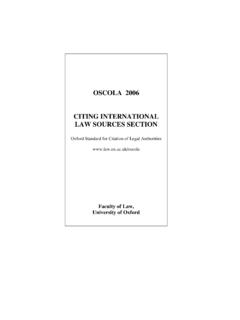
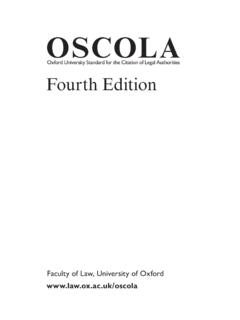
![[103R] THE 2019-2020 PRICE MEDIA LAW MOOT COURT ...](/cache/preview/0/4/6/0/a/d/7/4/thumb-0460ad74e87ef78c08fd83d0d32ab016.jpg)
![[103A] THE 2019-2020 PRICE MEDIA LAW MOOT COURT ...](/cache/preview/e/0/9/1/0/f/9/6/thumb-e0910f964b396d31bc82ce1e5ba8e0e8.jpg)




